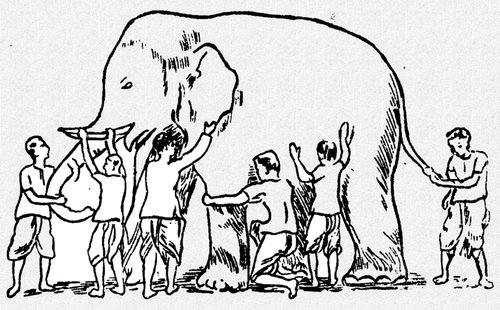Section 18.7. Understanding Our Elephant
18.7. Understanding Our ElephantThe information architecture community has much to learn from this expansive, honest, multifaceted approach to strategy. We are a young field, and we often resemble the illustration that accompanies "The Blind Men and the Elephant" (Figure 18-6). We have yet to develop our schools of thought. And our elephant is a complex, dynamic, and elusive beast. Building toward a collective understanding of information architecture is exasperatingly difficult. Figure 18-6. The Blind Men and the Elephant (image from http://www.jainworld.com/literature/story25i1.gif) As we continue to formulate our ideas and methods, we should be wary of those who expound a "one best way." We should embrace many definitions, many methods, and many facets. We should also be on the lookout for early indicators of trends that suggest new directions and new schools of thought for information architecture. It would be naïve to think our practice has matured in less than a decade. This is not to say that we haven't made great progress already. The practice of information architecture has come a long way since the early 1990s. We began with highly centralized, top-down approaches, attempting to leverage careful planning into stable solutions. We did some good work but learned the hard way that change is a constant and surprises should be expected. More recently, we've been exploring bottom-up approaches that tap the distributed intelligence within our organizations to nurture emergent, adaptive solutions. The following table compares classic or "top-down" IA to modern or "bottom-up" IA:
As we struggle with these ideas, an interesting question arises: do we create information architectures or reveal them? In Information Ecology, Thomas Davenport and Laurence Prusak have this to say on the topic: From an ecological perspective, identifying what information is available today and where it can be found is a much better use of architectural design than attempting to model the future. Information mapping is a guide to the present information environment. It may describe not only the location of information, but also who is responsible for it, what it is used for, who is entitled to it, and how accessible it is. This provocative statement is partly true, but it's also partly false. Information mapping is a useful approach that more of us should embrace, but it doesn't negate the value of other approaches. Remember, we are all blind men, and information architecture is our elephant. |
EAN: 2147483647
Pages: 194